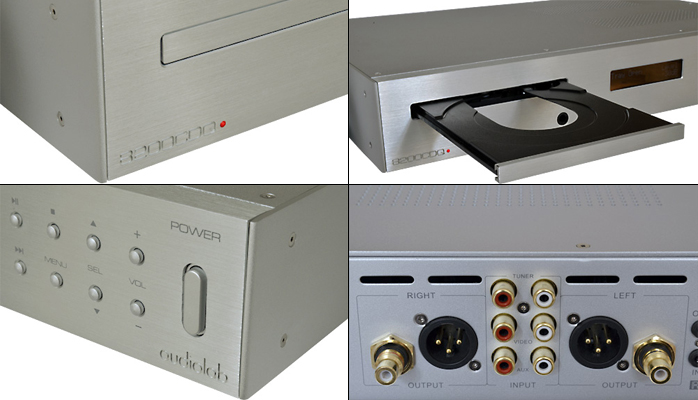This review page is supported in part by the sponsors whose ad banners are displayed below |
 |
 |
|
 |
 |
This review first appeared in the May 2011 issue of hi-end hifi magazine fairaudio.de of Germany. You can also read this review of the Audiolab 8200CDQ in its original German version. We publish its English translation in a mutual syndication arrangement with the publishers. As is customary for our own reviews, the writer's signature at review's end shows an e-mail address should you have questions or wish to send feedback. All images contained in this review are the property of fairaudio or Audiolab - Ed.
|
Reviewer: Markus Sauer
Sources: Analog – deck - Garrard 401; arm - Naim Aro; cart - Lyra Skala; digital - Heed Obelisk DT CD-+ DA converter
Amplification: Phono- Tom Evans The Groove+ SRX; preamp - Tom Evans The Vibe+ with Pulse PSU – power amp - Bryston 3B SST, Jeff Rowland 102
Loudspeakers: Harbeth SHL5, JBL LSR 6332, Audio Physic Virgo 25
Review component retail: €1.199
|
|
Take three. The Audiolab brand originated in the UK roughly 30 years ago with Philip Swift (present owner of Spendor) and Derek Scotland. In Germany Audiolab appeared for a spell as Camtech. Design and production today are in China under "deep vertical integration". After a pit stop with TAG McLaren the brand now belongs to the International Audio Group. German distribution occurs by way of the IAD GmbH in Düsseldorf.
|
 |
The proper spelling of Audiolab is uncertain. The manufacturer uses a small ‘a’ for the machine and brochure, a capital ‘A’ for the owner’s manual and in advertisements. I’ll go with the latter. Certain folks in the English-speaking world have anticipated the arrival of today’s 8200CDQ with great eagerness. That’s because it was designed by John Westlake who 20 years ago was responsible for the Pink Triangle marquee—may it rest in blessed peace—and who of late contributed to various Peachtree Audio machines. Responsibility for today’s player software goes to Dominik Peklo by the way.
|
|
|
|
John Westlake has long since established a devout following on www.diyaudio.com, the world’s largest DIY forum. For many years he openly shared his progress on a DAC that was expected to launch under his own Lakewest brand but which eventually manifested as Audiolab product.
|
|
|
Westlake has also contributed to the British audio forum Pink Fish Media and particularly this thread contains admirably forthcoming data on his approach which included incorporating certain participants' suggestions into series production such as a 12V triggers to fire up external amps or active speakers.
|
 |
During my visit with the German importer, John Westlake kindly made himself available to explain to me the Audiolab 8200 CDQ at greater lengths. He’s an interesting chap who at a mere 17 years of age already launched his first company in computer services. This he sold at 21 to mostly continue work as consultant to other firms and predominantly in audio. With a father of English/Irish extraction and a Czech mother he spent his first five years in the Czech Republic before the family emigrated to the UK to leave behind a crippling recession under the country's then regime. Asked what got him into China Westlake explained that having designed a machine in 1994, he'd ordered it made in China but six months passed without a delivery to cause him to fly out and check up on status in person. From that trip he simply never really returned but expatriation to the Czech Republic seems to be finally in the works.
|
|
|
Enough foreplay. The Audiolab 8200CDQ combines a CD player, DAC and preamp in one box which reflects in its nomenclature. ‘C’ is for CDP, ‘D’ for DAC and ‘Q’ for preamp. Hence there are—or will be—spin-offs like the 8200CD (player + DAC), 8200DQ (DAC + preamp) and 8200Q (preamp). In Germany the 8200 CDQ retails for €1.200.
This machine is impressively featured with coaxial and optical digital outputs and RCA/XLR analog outs. There also are two coax and Toslink digital inputs each plus USB which is officially spec’d for ‘just’ 24/96 like the S/PDIF sockets but which in practice apparently is often compatible with 192kHz rates. Output voltage can be controlled in the analog or digital domains. As an analog preamp there are three high-level inputs without phono. Last but not least there’s a headphone socket which due to lack of ‘phones and interest I didn’t test; and a remote wand.
|
 |
To avoid filling pages with what each control button does, interested readers are referred to the company website with its downloadable owner’s manual which contains an admirably comprehensive and useful chapter also on PC-Fi for both Windows and OSX users. The digital heart which beats steadily is the ESS Sabre 9018 32-bit chip which Westlake considers the best integrated chip currently available. Because this machine processes audio signal at maximally 24 bits whilst the chip contains eight discrete 32-bit DACs, there’s plenty of computational headroom for digital attenuation. The Sabre chip implements great flexibility in defining reconstruction filters and the 8200CDQ accordingly gets quite a range of filter options. The master clock sits right adjacent to the DAC to minimize jitter. The motherboard is a 4-layer affair whose exact layout took John Westlake four months to refine before it was fully optimized.
|
 |
|
 |